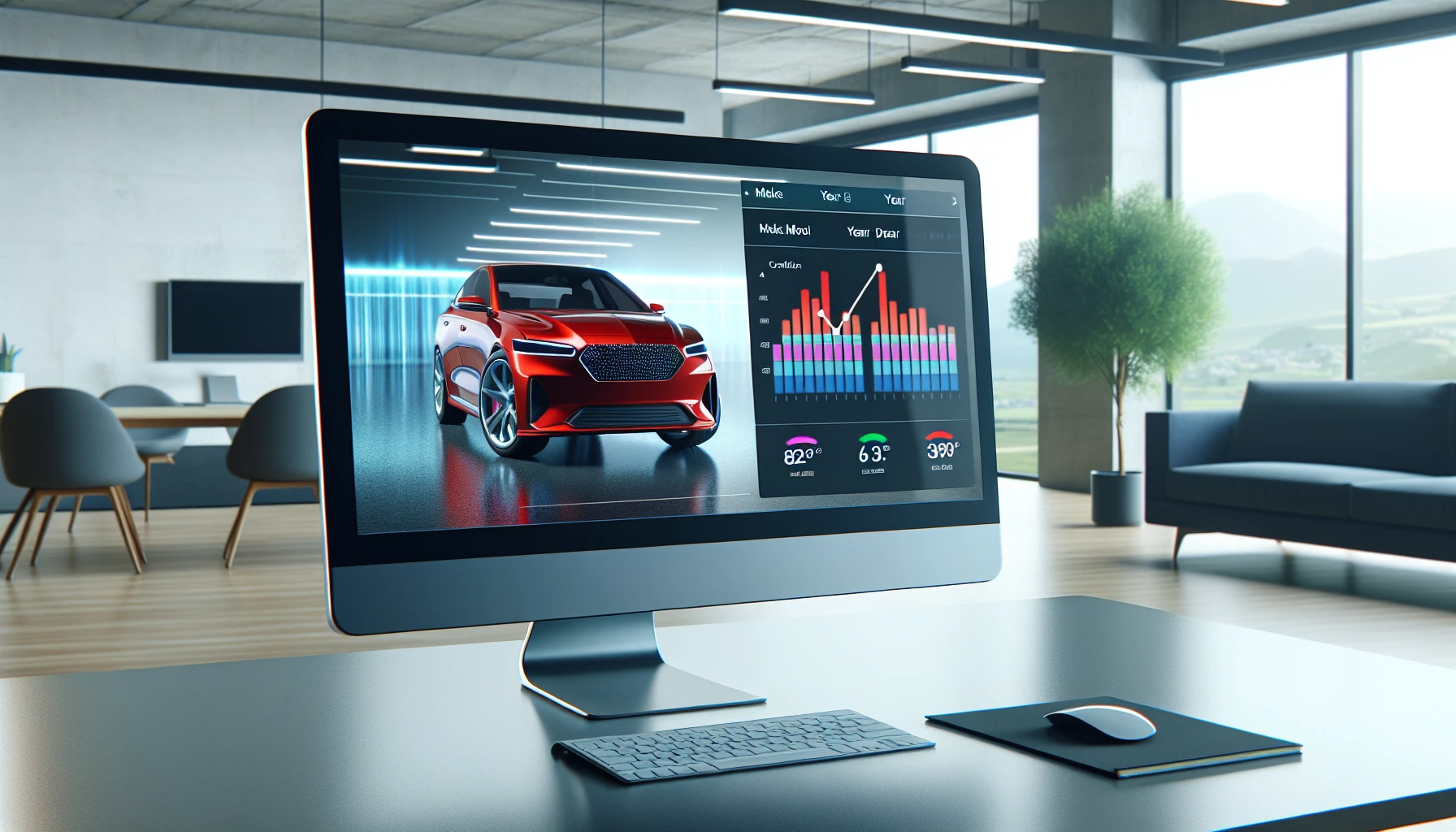Are you considering selling your car and want to get the best possible price in the shortest amount of time? You’ve come to the right place! This comprehensive guide on “how to sell your car” will walk you through efficient strategies to sell your car fast and get top dollar. Learn how to evaluate your car’s worth, prepare it for sale, create an attractive online listing, choose the right platform, and negotiate with potential buyers. By the end of this guide, you’ll be equipped with the knowledge and confidence to sell your car quickly and for the highest possible value.
Key Takeaways
Assess your car’s worth using online valuation tools and consider market demand.
Prepare your car for sale by making repairs, detailing, gathering necessary documents & creating an attractive online listing.
Handle legal and financial considerations such as loans/negative equity & transfer of license plate/registration when selling a vehicle.
Evaluating Your Car’s Worth

The first step in selling your car is to determine its worth. This will help you set a competitive asking price and understand what to expect from potential buyers. This segment outlines the usage of online valuation tools, evaluation of market demand, and the assessment of your car’s condition and mileage to determine an accurate value.
Using Online Valuation Tools
When it comes to estimating your car’s value, online valuation tools like Kelley Blue Book and NADA Guides can be invaluable resources. These tools take into account factors such as make, model, year, condition, and mileage to provide an instant offer online. Kelley Blue Book, for example, is known for its accuracy in estimating car values by considering the vehicle’s history and condition.
NADA Guides, on the other hand, calculates car values based on actual sales data from automobile dealerships, giving you a realistic picture of what your car is worth in the current market. Keep in mind that these tools are continually updated to reflect prevailing market trends and pricing information. Utilizing online valuation tools provides a dependable basis for establishing your asking price.
Considering Market Demand
Market demand plays a significant role in determining your car’s resale value. Factors that contribute to market demand for a particular car make and model include:
Economic conditions
Interest rates
Unemployment rates
Household income
Market growth rate
Previous month’s dealer sales
High demand for a specific make or model can result in a higher resale value, while low demand can lead to a decrease in value.
To evaluate the desirability of your car’s make and model among potential buyers, consider its design, styling, and overall condition. Analytical sourcing and bidding models that use real-time market data can also help you assess the demand and popularity of certain car models in the market. Comprehending market demand aids in setting a competitive asking price and drawing interested buyers.
Assessing Condition and Mileage
Assessing your vehicle’s condition plays a key role in establishing its value. Be sure to consider the following factors:
Exterior and interior condition
Mechanical condition
Vehicle history
Mileage
Reputation
Ownership and title documents
Keep in mind that higher mileage usually leads to more wear and tear, making the vehicle less valuable than those with lower mileage. Generally, a pre-owned vehicle with up to 100,000 miles is considered to be of high mileage.
Honesty and precision are imperative when revealing your car’s condition to potential buyers. Transparency in this regard will not only help you avoid any potential disputes but also build trust with prospective buyers, increasing the chances of a successful sale.
Preparing Your Car for Sale

Before listing your car for sale, it’s important to ensure it’s in the best possible condition to attract buyers. This segment outlines the process of making necessary repairs, detailing your car, and compiling the required documents to ensure a seamless sales procedure.
Making Repairs and Detailing
Addressing minor issues before listing your car for sale can make a significant difference in its appeal to potential buyers. Some recommended repairs include:
Washing and detailing the car
Replacing headlamps
Cleaning foggy headlights
Changing or refilling fluids
Addressing any visible issues such as a cracked windshield or lens cover.
Detailing your car is key in enhancing its appeal to buyers. Here are the steps to follow:
Clean the exterior, including the wheels, tires, and windows.
Vacuum the seats, carpets, and floor mats.
Wipe down plastic, wood, and metal components inside the car.
Pay attention to the details, such as cleaning the windows, polishing the exterior to remove scratches or swirl marks, and applying a protectant to the tires.
A well-presented car can fetch a higher price and draw more interest from buyers.
Gathering Necessary Documents
Gathering all the necessary documents is important when selling your car to ensure a seamless transaction. These documents include:
Car title
Registration
Bill of sale
Release of liability
Maintenance and repair records
Vehicle history report
Warranty documents
Owner’s manual
Having these documents readily available will not only make the process more efficient but also help build trust with potential buyers. Providing a complete and transparent record of your car’s history and maintenance demonstrates that you have taken good care of the vehicle, making it more appealing to buyers.
Creating an Attractive Online Listing
A compelling online listing captures the attention of potential buyers, leading to a quicker sale. This segment covers the vital elements of crafting an engaging listing, including developing a detailed description, taking high-quality photos, and revealing your car’s history.
Writing a Detailed Description
A detailed description of your car is vital in drawing in interested buyers. Be sure to include the make, model, year, mileage, and any unique features or modifications. When crafting the car description, ensure that it is punchy and accurately highlights the positive traits and key selling points. Utilize proper grammar and spelling, and include all relevant specifications such as the engine, transmission, brakes, wheels/tires, and interior features.
Additionally, when selling a car, it is important to:
Research the car’s history and condition
Be transparent about any known issues or repairs
Provide a well-written, accurate description that conveys professionalism and builds trust
Capturing Quality Photos

High-quality photos showcasing your car’s condition and features are crucial in pulling in potential buyers. Aim to include at least ten photos that display the car from various angles, both exterior and interior. Additionally, close-ups of key features should be included.
When photographing your car, follow these tips:
Ensure proper lighting conditions
Avoid cluttered backgrounds
Capture the car’s exterior and interior in detail
Consider using a tripod for stability and sharpness in your photos.
Using multiple photos can significantly enhance your listing’s appeal and increase the chances of a successful sale.
Disclosing Vehicle History
Transparency about your car’s history is vital in fostering trust with potential buyers. Disclose any accidents or major repairs, as well as any outstanding loans or negative equity. Providing a vehicle history report can also be helpful in demonstrating your car’s history and condition.
By disclosing your car’s history, you’ll not only avoid potential disputes down the line but also increase the likelihood of attracting serious buyers who appreciate your honesty and transparency.
Choosing the Right Platform to Sell Your Car Online
Choosing the appropriate online platform for selling your car, given the myriad of options, maximizes your chances of a successful sale. This segment examines popular car selling websites and specialized sites for unique vehicles to help you identify the optimal platform for your specific car and circumstances.
Popular Car Selling Websites
Websites like Cars.com, Carvana, and CarMax are popular choices for selling cars online, offering a convenient and efficient selling experience. These sites typically require photos and a detailed description of your car, as well as a vehicle history report.
When using these websites, it’s important to compare offers from various sources to ensure you receive the most advantageous deal. The benefits of using the best site for these services include a convenient and rapid sale process, no-haggle offers, and an instant cash offer.
Specialty Sites for Unique Vehicles
For unique or niche vehicles, such as classic cars or motorcycles, consider using specialty sites to reach a targeted audience. Some examples include:
Hemmings: specializes in rare and collectible cars
Bring-A-Trailer: also focuses on rare and collectible cars
Cycle Trader: caters to motorcycles
eBay Motors: offers a wide range of vehicles, including motorcycles
Using these specialty sites can help you connect with buyers who are specifically interested in your type of vehicle, or even find a local dealer who specializes in it.
By listing your unique vehicle on a specialty site, you’re more likely to attract buyers who are specifically interested in your car’s make and model, increasing your chances of a successful sale.
Negotiating with Online Car Buyers

Once you’ve created an attractive listing and chosen the right platform, such as Facebook Marketplace, it’s time to negotiate with potential buyers. In this section, we’ll discuss setting a fair price, handling offers and inquiries, and finalizing the sale to ensure a smooth transaction.
Setting a Fair Price
Setting a competitive asking price is crucial in attracting potential buyers. To set a fair price, you should:
Conduct market research
Check pricing guides
Survey the competition
Examine any relevant data
Consider factors such as your car’s valuation, market demand, and similar listings
By following these steps, you can arrive at an accurate asking price for your car.
By setting a fair and competitive price, you’ll increase your chances of attracting serious buyers and reaching a mutually beneficial agreement.
Handling Offers and Inquiries
As offers and inquiries start coming in, it’s important to respond promptly and professionally. Here are some tips for handling inquiries:
Acknowledge the inquiry in a timely manner.
Express gratitude for their interest.
Provide accurate information about your car’s condition and features.
Be prepared to negotiate on price or terms, as potential buyers may try to secure a better deal.
When managing offers, consider multiple offers, verify the buyer’s information, and close the deal securely. By handling offers and inquiries effectively, you’ll increase your chances of a successful sale.
Finalizing the Sale
Once you’ve agreed on a price and terms with a buyer, it’s time to finalize the sale. This includes agreeing on payment terms, signing necessary documents, and transferring ownership. Common methods of payment when selling a car online include bank payment, cash, cashier’s check, or electronic transfer.
To complete the sale, you’ll need to provide the car title, registration, and bill of sale. Ensure a smooth transfer of license plate and registration by following your state’s requirements and providing necessary documentation. By taking these steps, you’ll ensure a successful transaction and a seamless transfer of ownership.
Trade-In versus Private Sale
If you’re contemplating whether to trade-in or privately sell your car, this segment evaluates the benefits of both options. We consider factors such as convenience, potential tax advantages, and profit maximization.
Benefits of Trading In
Trading in your car at a dealership can offer convenience and potential tax benefits, but may result in a lower sale price. The process typically involves the following steps:
The dealership will assess the value of your car based on the market.
They will subtract that amount from the price of the new car you’re purchasing.
You may need to negotiate the trade-in value to ensure you’re getting a fair deal.
While trading in your used car can be a good option for those who value convenience and potential tax advantages, it’s important to keep in mind that the amount offered by the dealership may be lower than what you could obtain through a private sale.
Maximizing Profit through Private Sale
Selling your car privately can yield a higher profit, but requires more effort in terms of marketing, negotiation, and paperwork. By selling your car privately, you have more control over the selling process and can potentially secure a higher sale price.
However, selling your car privately also involves more work, such as creating an attractive listing, responding to inquiries, and handling paperwork. Despite the additional effort, a private sale can be a more profitable option for those willing to invest the time and energy into the process.
Legal and Financial Considerations
Legal and financial considerations are important when selling your car. This segment explains how to handle loans and negative equity, and the transfer of license plate and registration for a seamless and legally compliant sale.
Dealing with Loans and Negative Equity
If you have a loan or negative equity on your car, selling it can be more complicated. Negative equity occurs when the amount owed on the car loan surpasses the current value of the car. In such cases, you may need to pay off the balance of the loan before selling the car or transfer the loan to another individual.
When selling a car with outstanding loans or negative equity, it’s crucial to disclose this information to potential buyers and ensure the transaction is handled properly to avoid any legal issues.
Transfer of License Plate and Registration
Transferring your car’s license plate and registration, including the license plate number, is a critical step in the selling process. To ensure a smooth transfer, follow your state’s requirements and provide necessary documentation, such as the car title, registration, and bill of sale.
By adhering to your state’s requirements and providing accurate documentation, you’ll not only ensure a successful sale but also protect yourself from any potential legal issues that may arise after the transaction.
Summary
In conclusion, selling your car fast and for top dollar involves evaluating its worth, preparing it for sale, creating an attractive online listing, choosing the right platform, negotiating with buyers, and addressing legal and financial considerations. By following the strategies outlined in this guide, you’ll be well-equipped to sell your car quickly and at the highest possible value. So, why wait? It’s time to put these tips into action and get your car sold!
Frequently Asked Questions
Who pays the most for selling your car?
For selling your car, CarMax is the best option as they consistently offer prices that are higher than the KBB trade value. Additionally, they are known for offering a quick and easy transaction experience with no hassle.
Where is the best place to sell a car?
Cars.com, Carvana, Peddle, CarMax, Copart, CarGurus, Vroom, AutoNation and Facebook Marketplace are the best places to sell a car online for good value.
What online valuation tools can I use to estimate my car’s value?
Kelley Blue Book and NADA Guides are two reliable options to estimate the value of your car online.
How can I make my car more appealing to potential buyers?
Address any minor issues, give your car a thorough clean inside and out, and consider professional detailing to boost its appeal for potential buyers.
What documents are required to complete the sale of a car?
Completing the sale of a car requires the car title, registration, bill of sale, release of liability, maintenance and repair records, vehicle history report, warranty documents, and owner’s manual.
